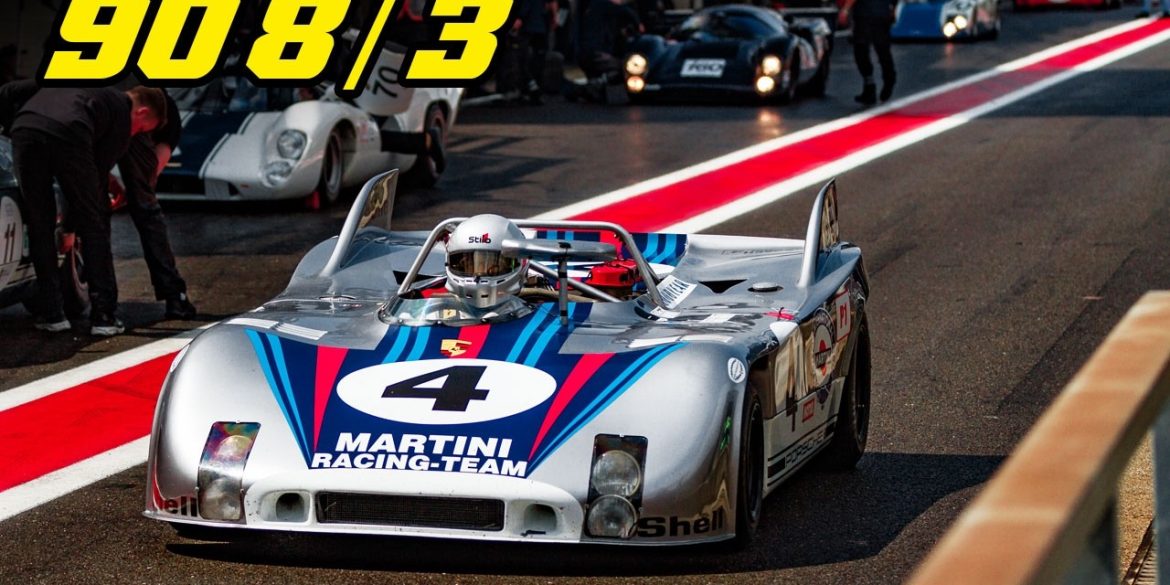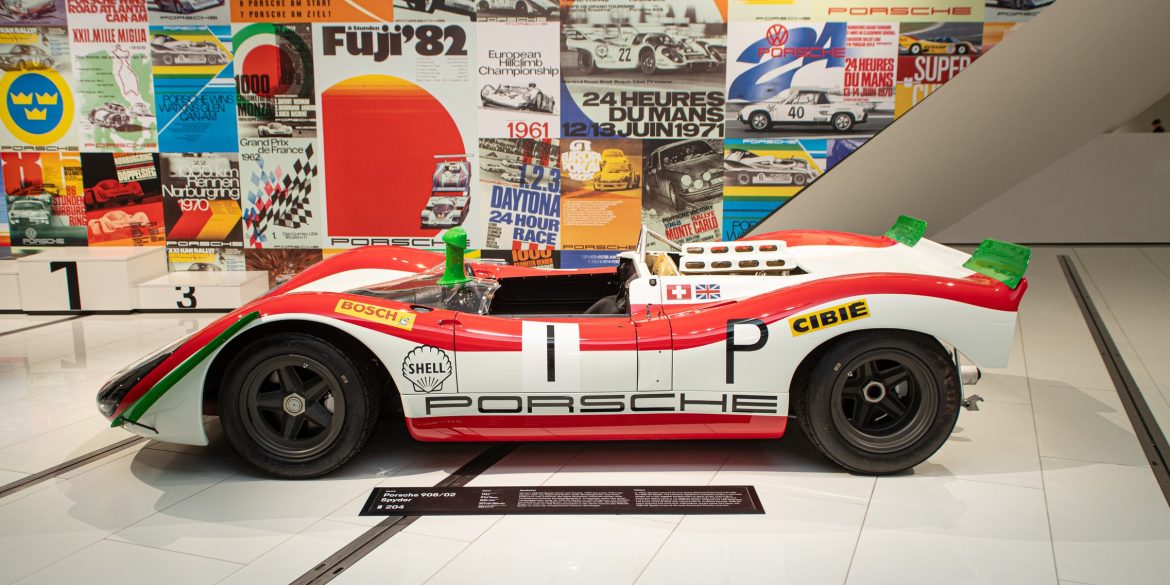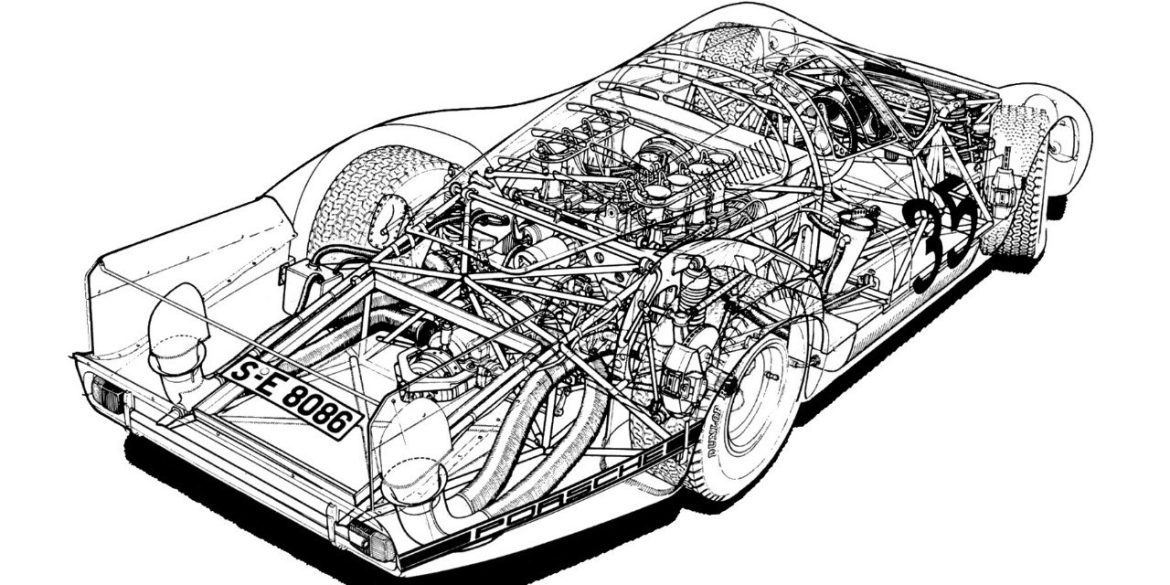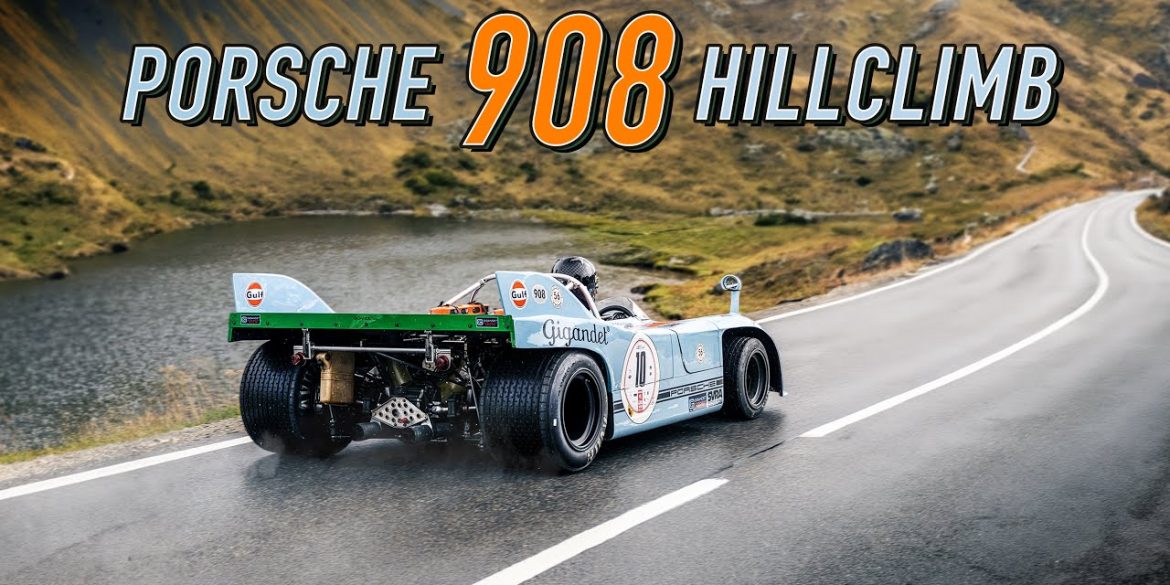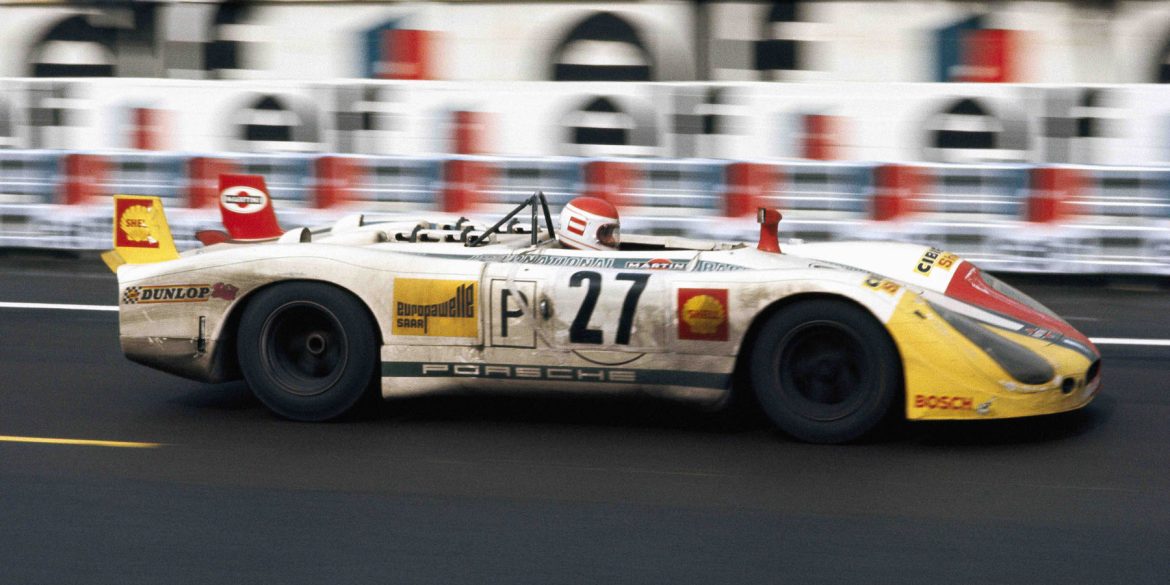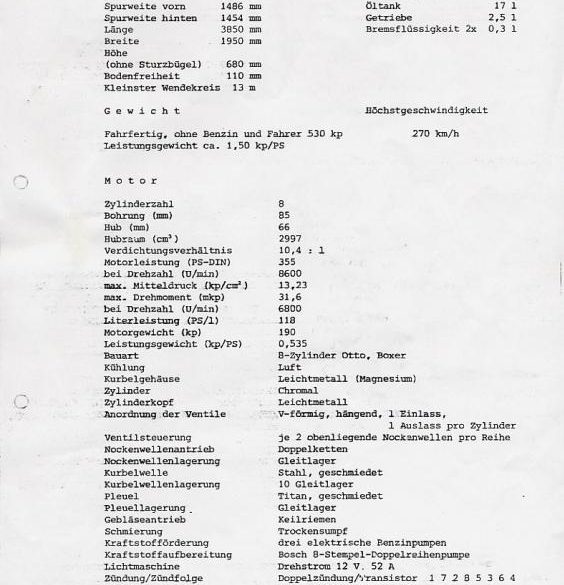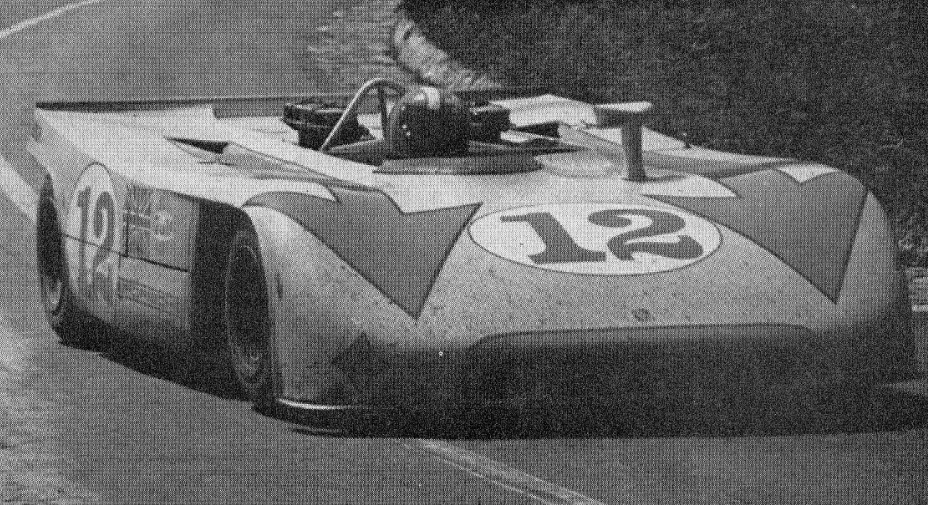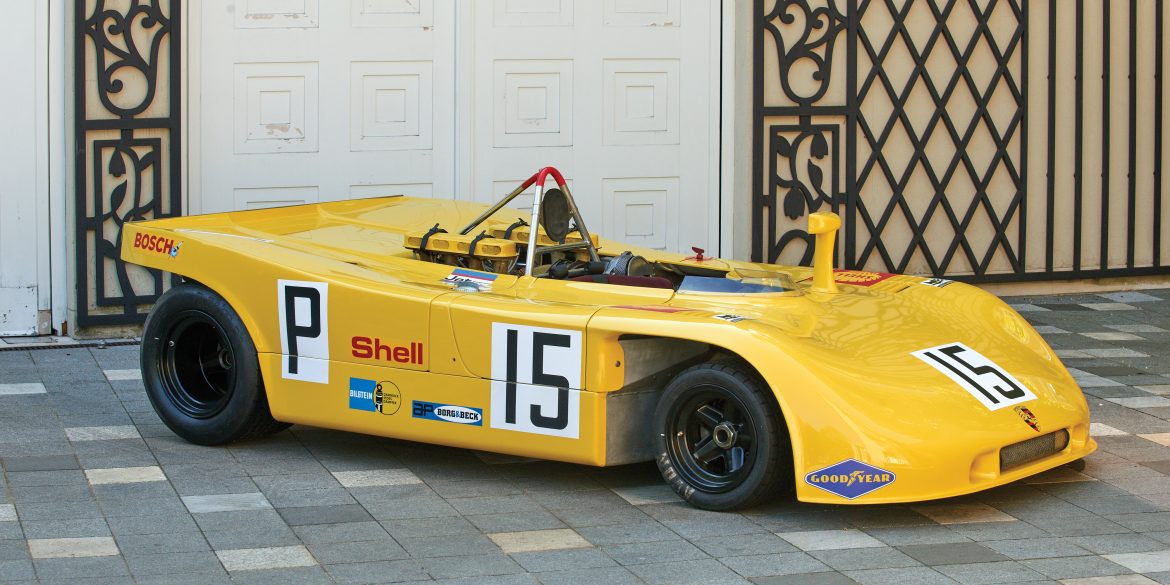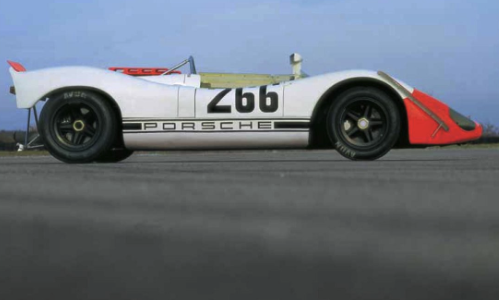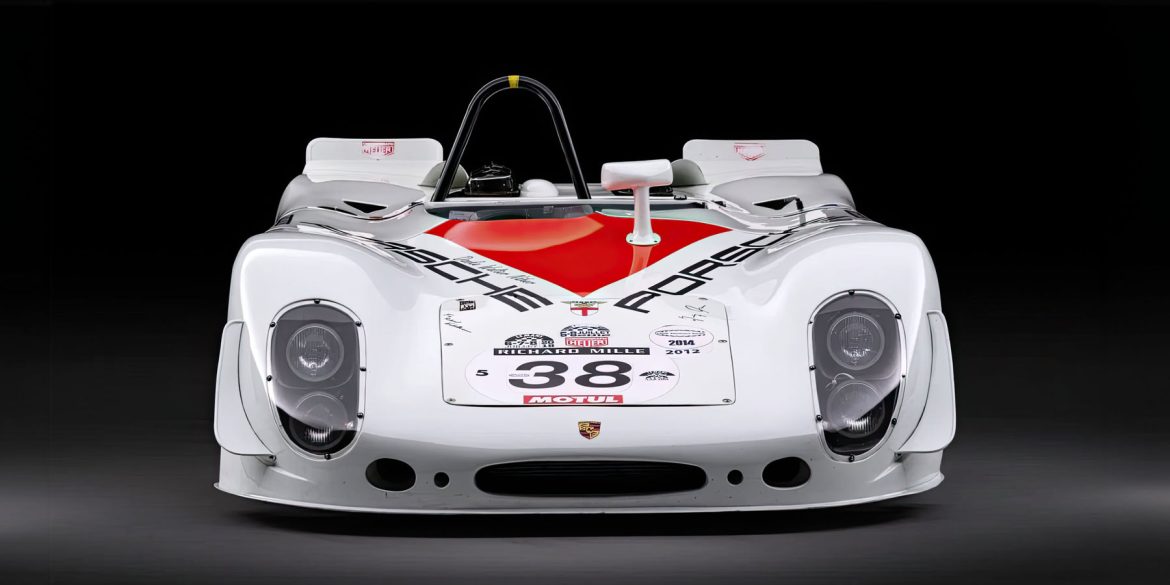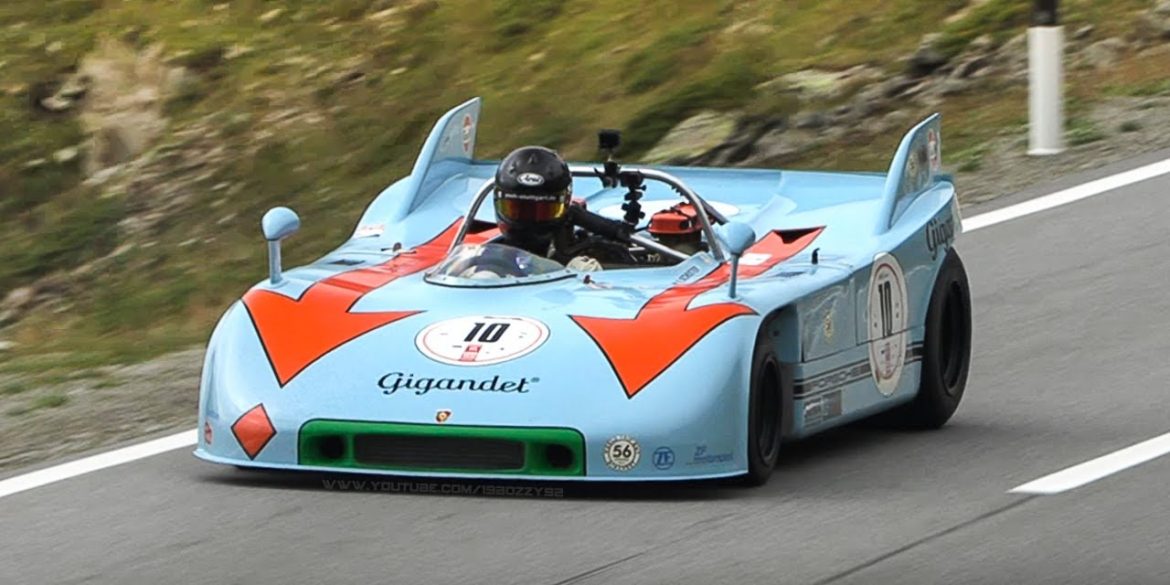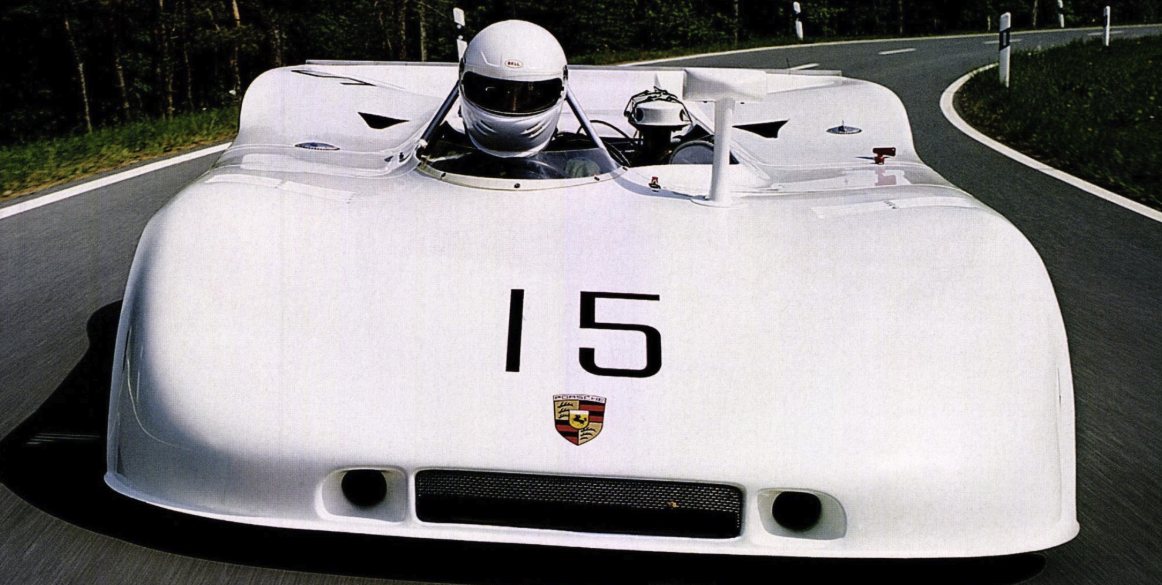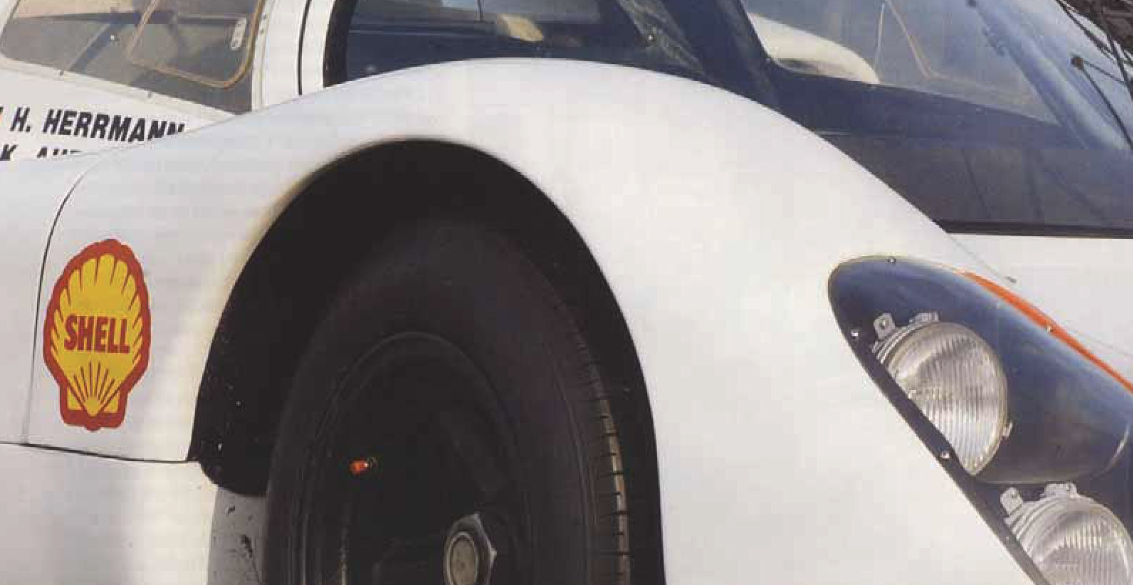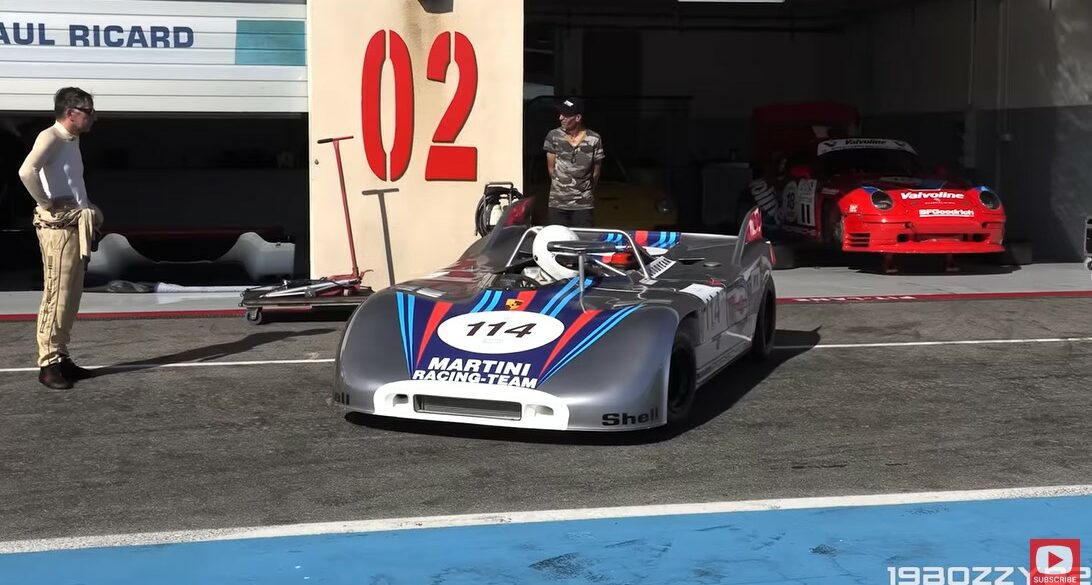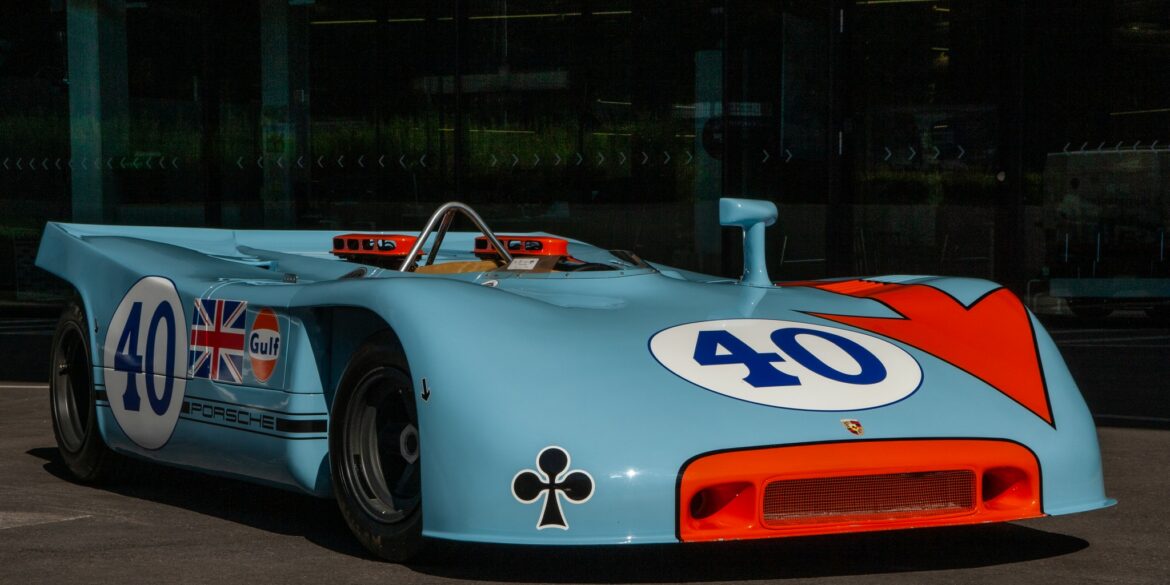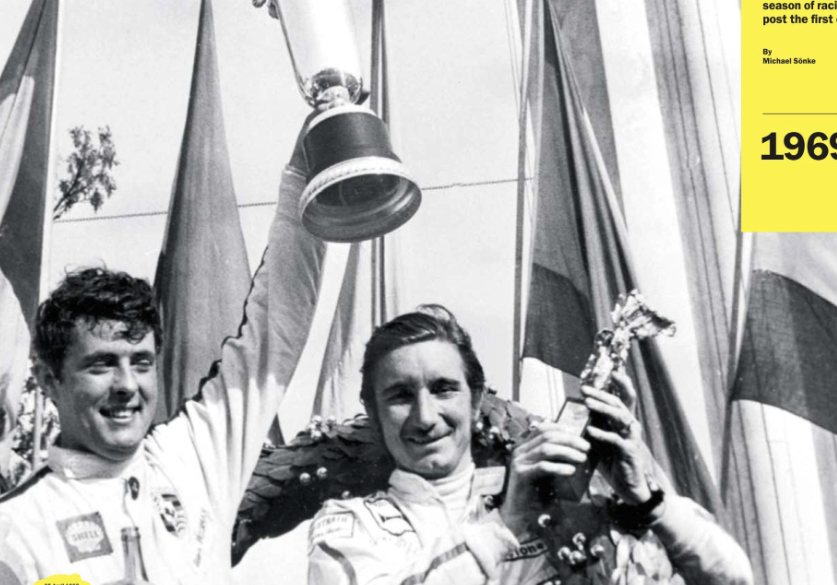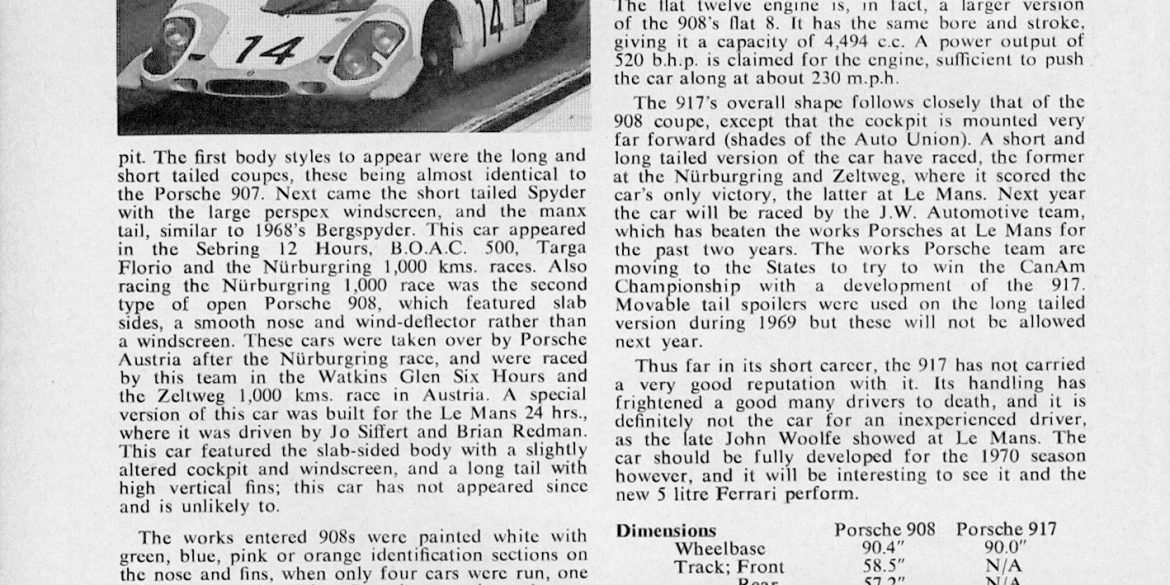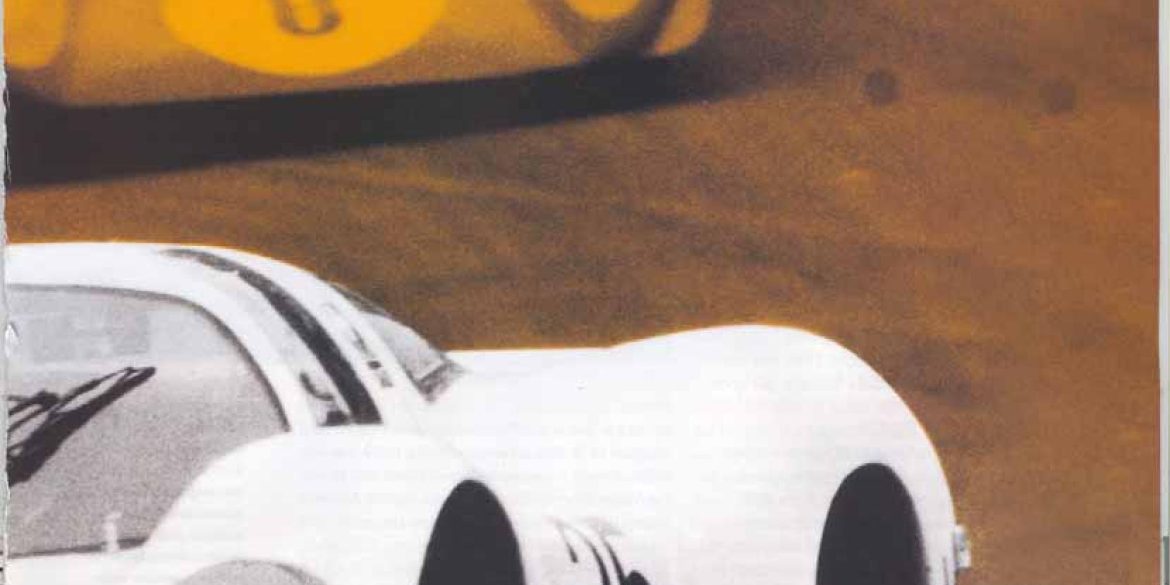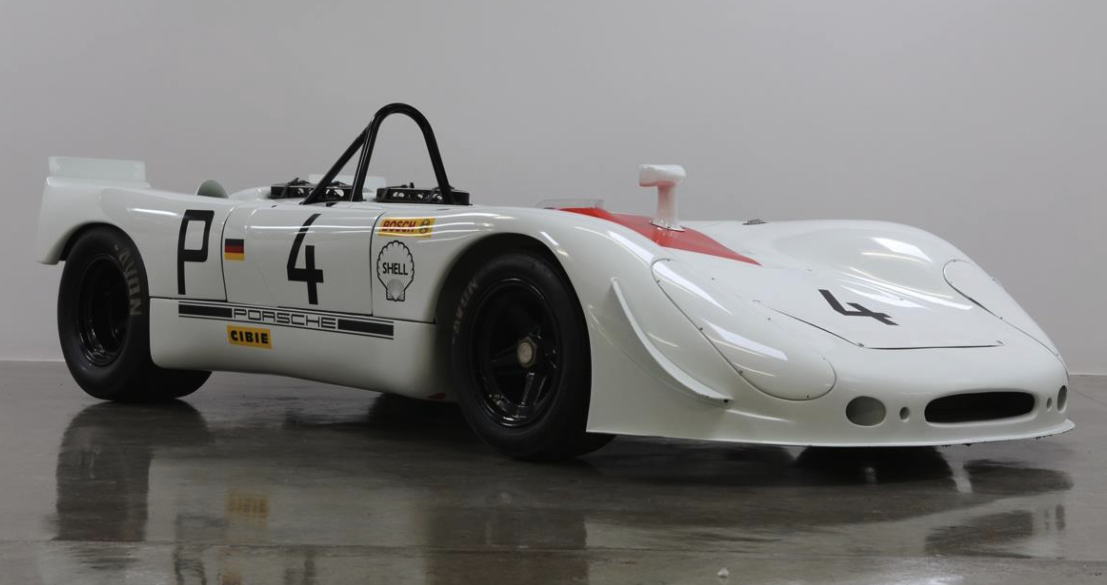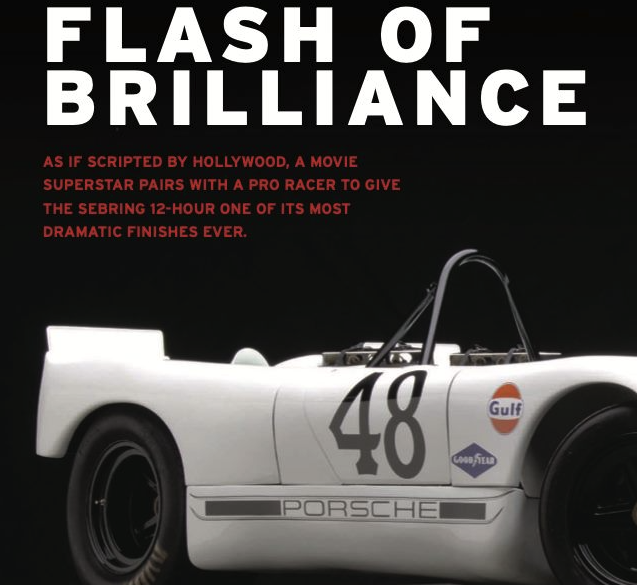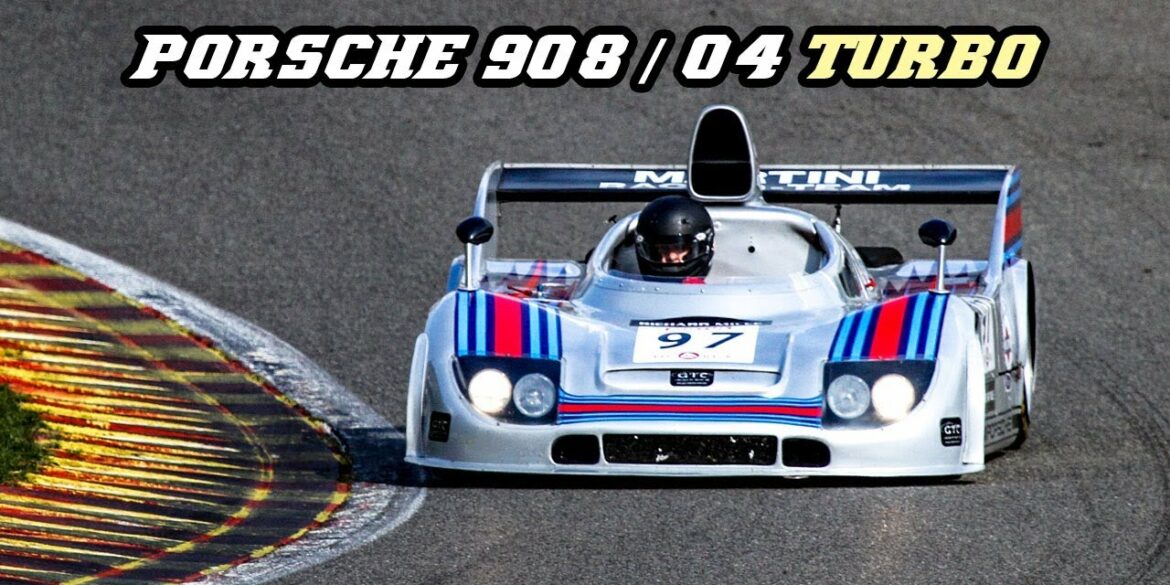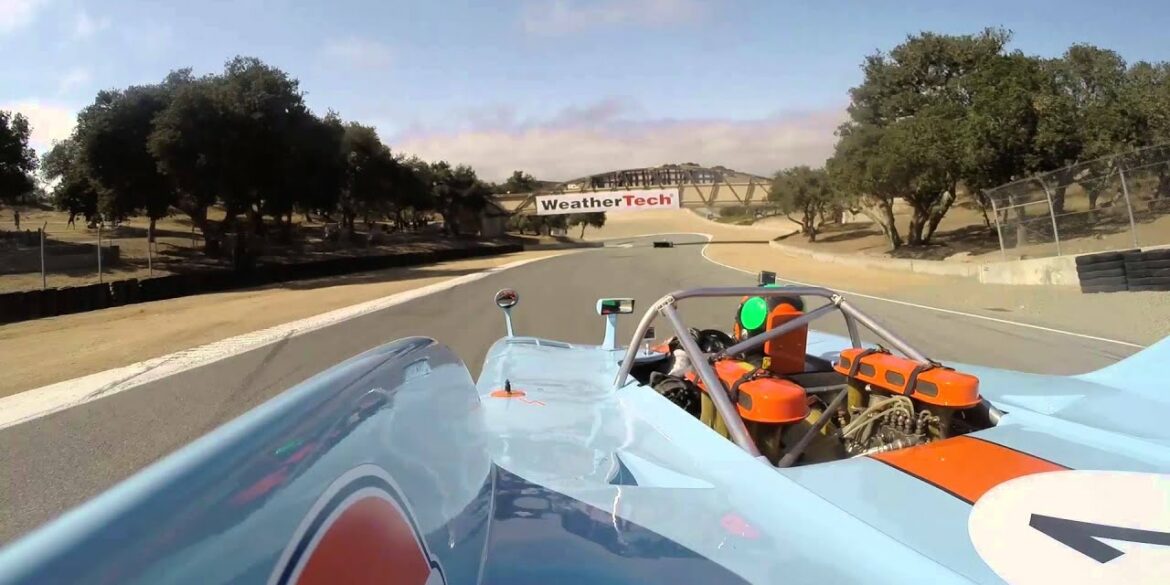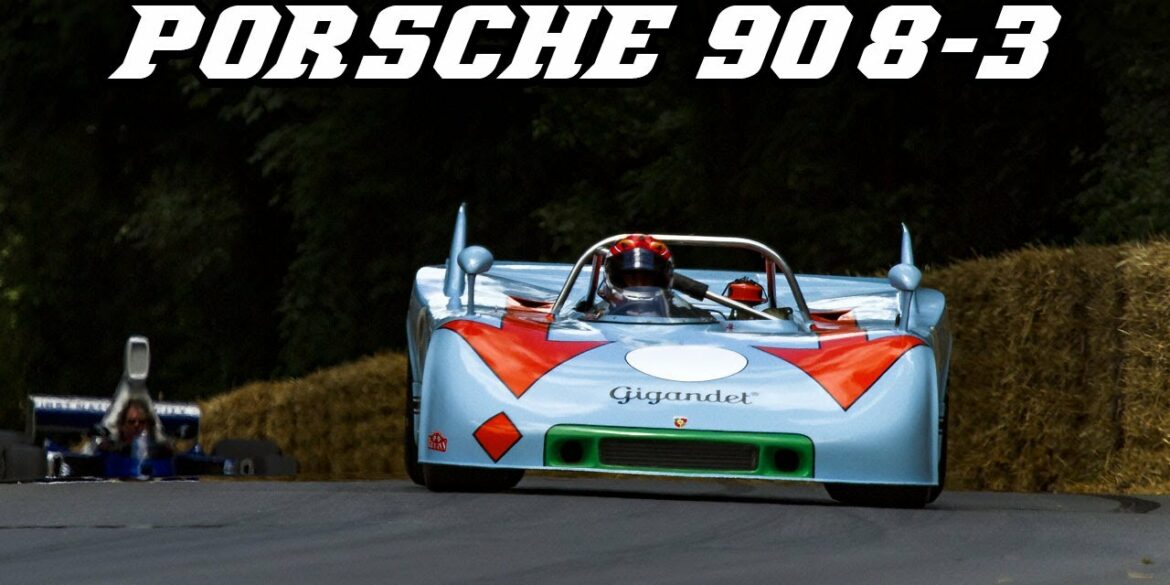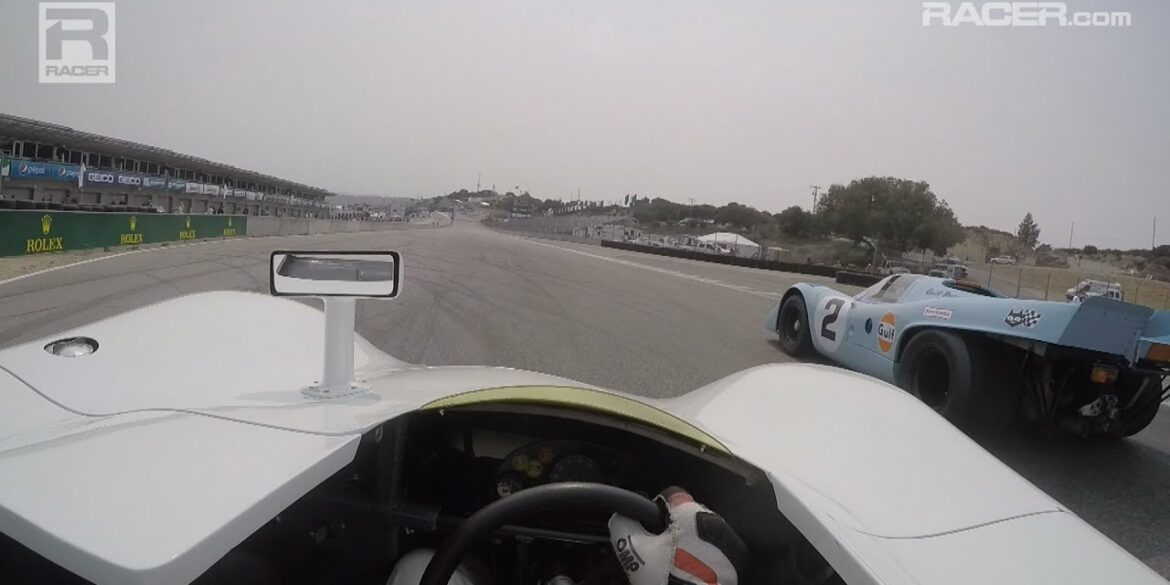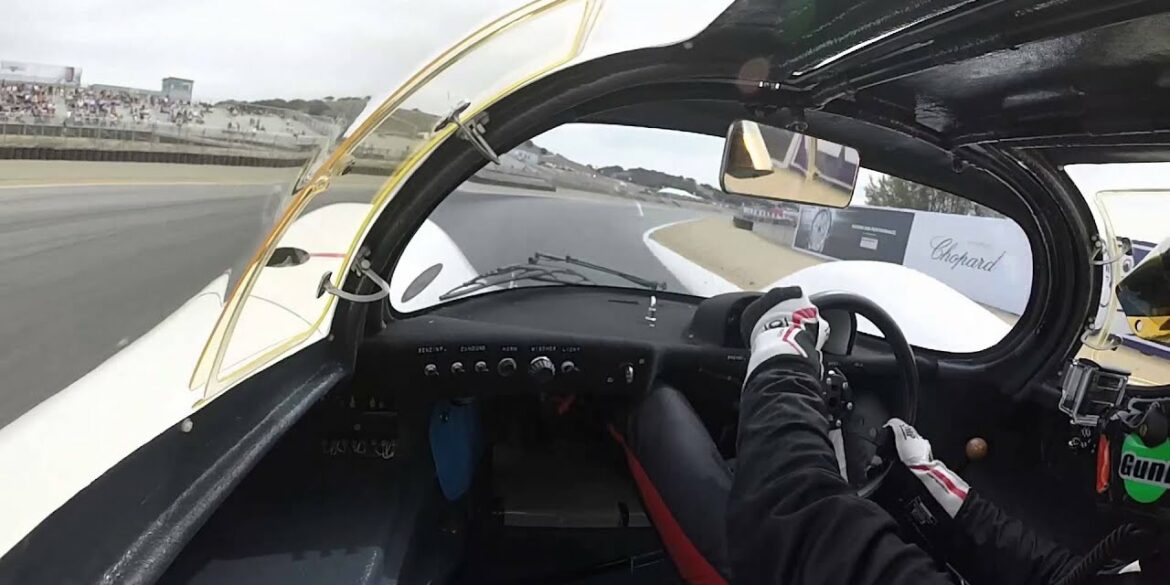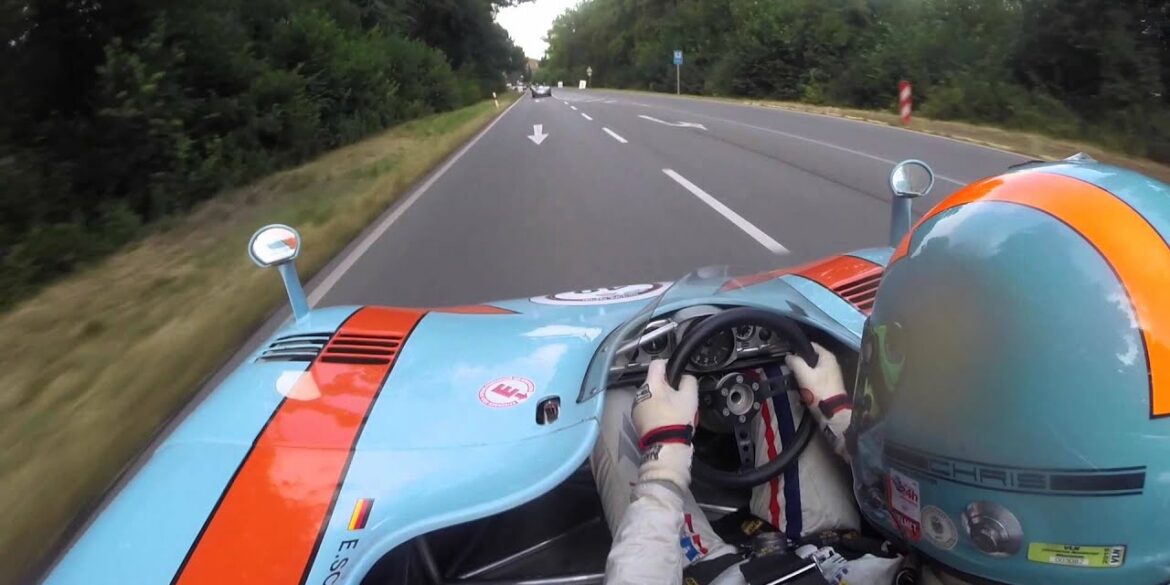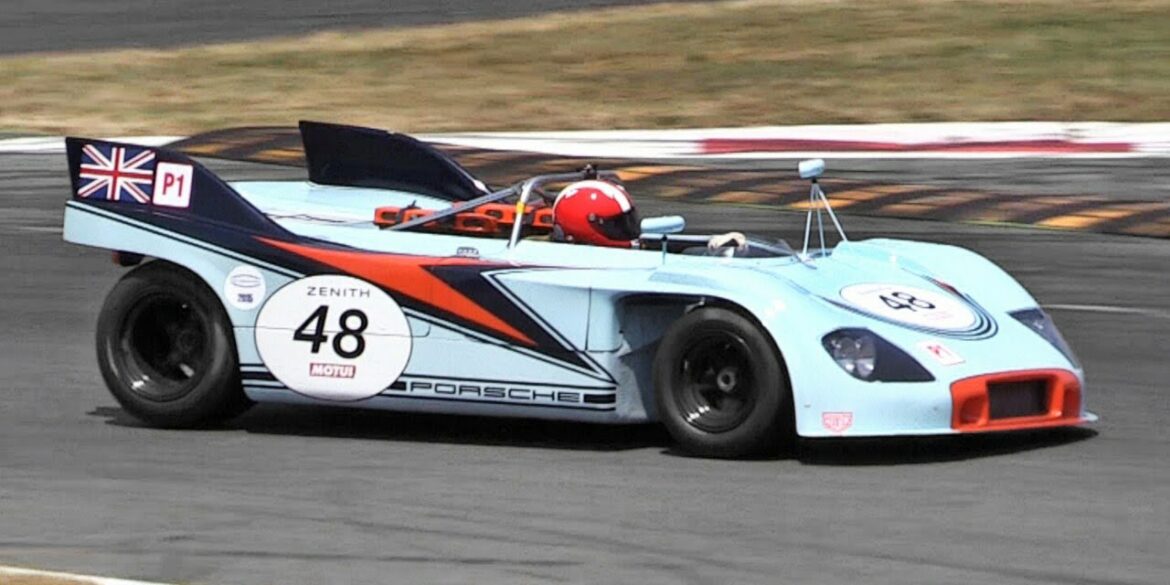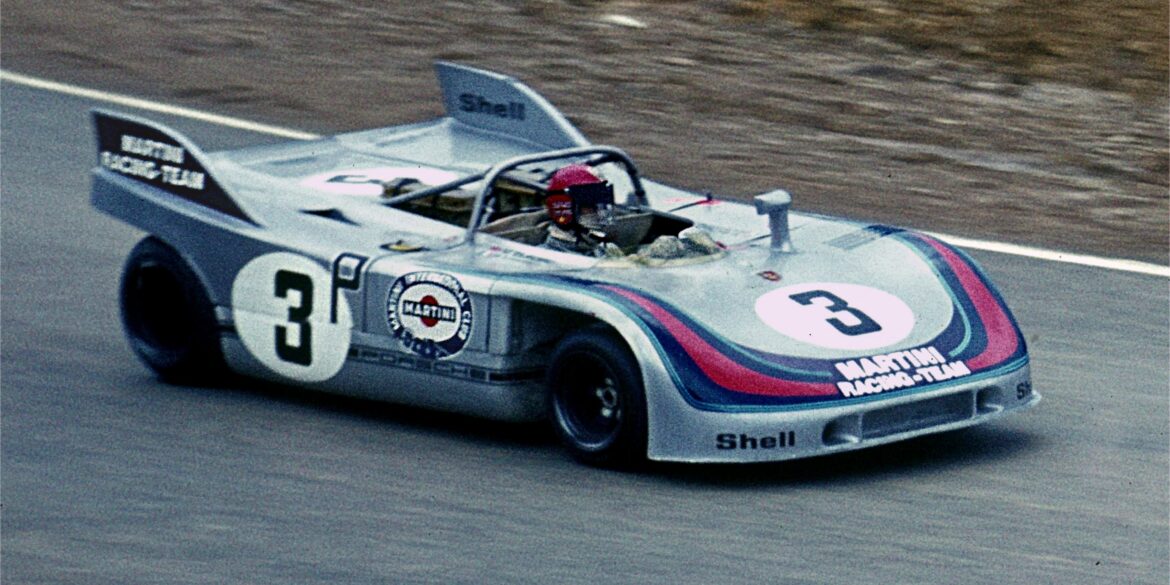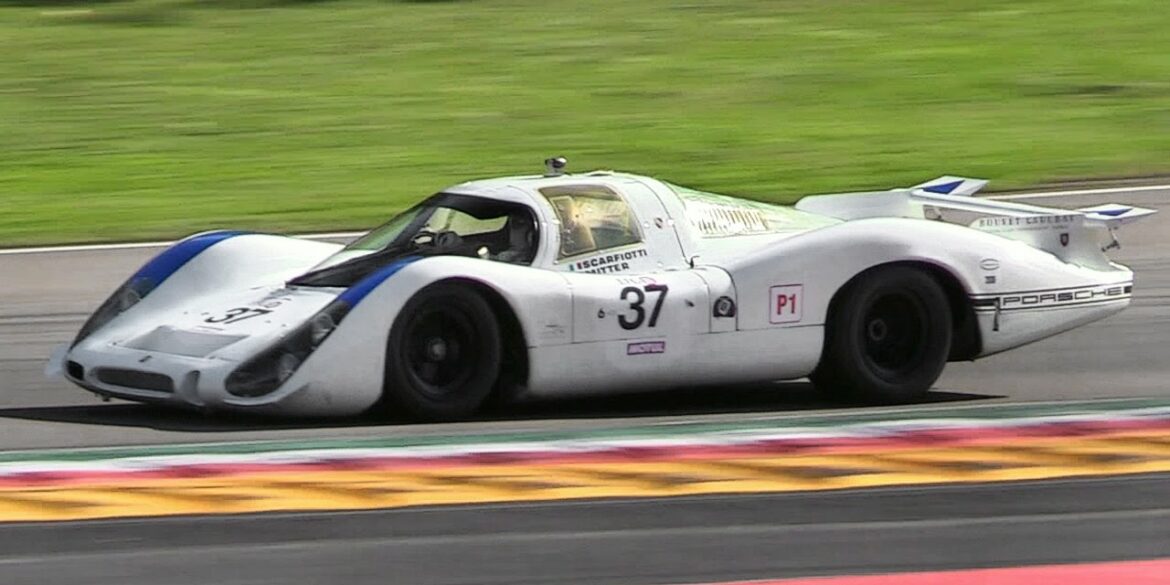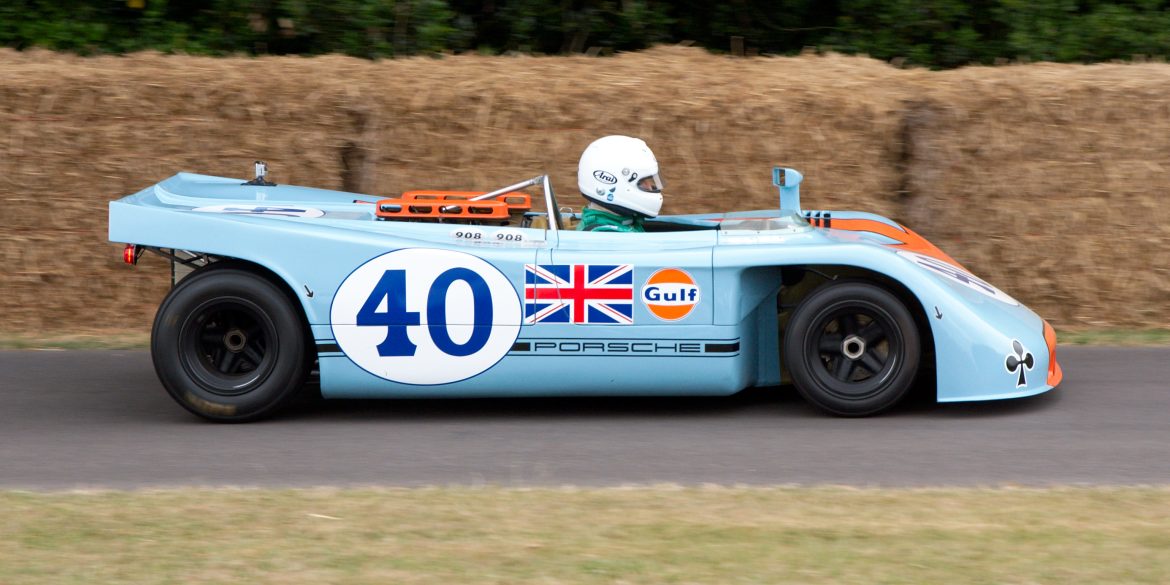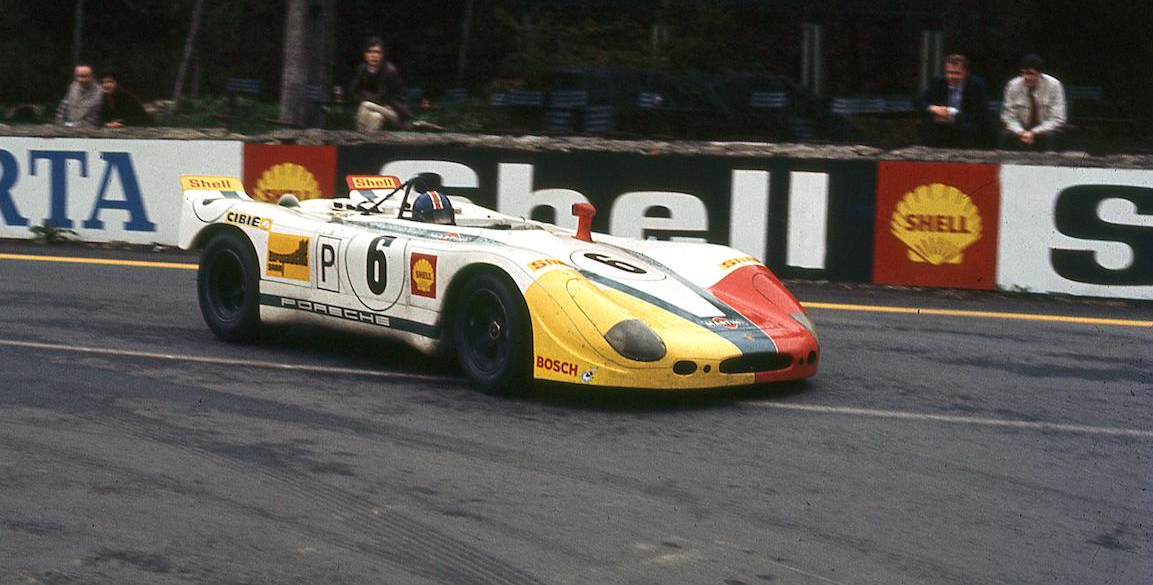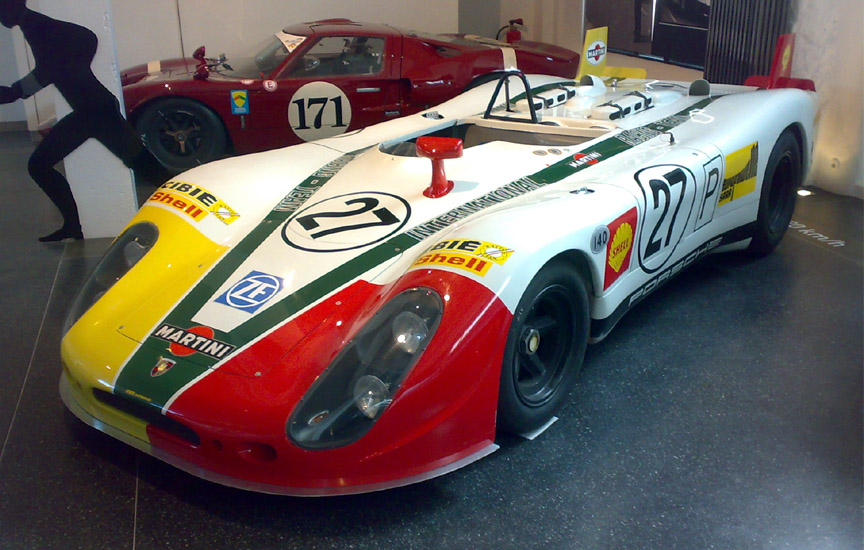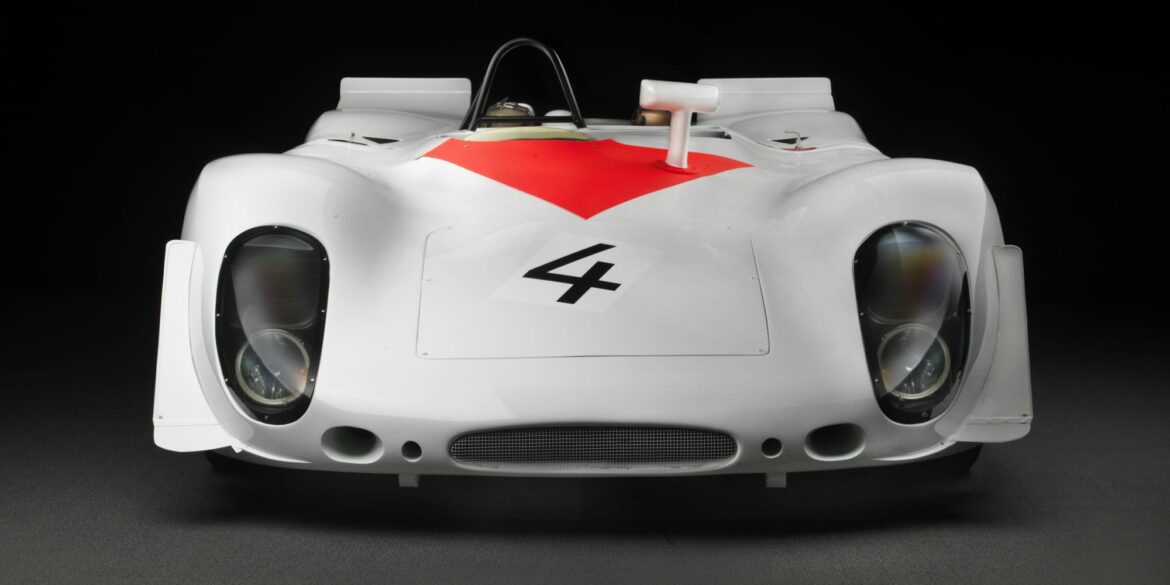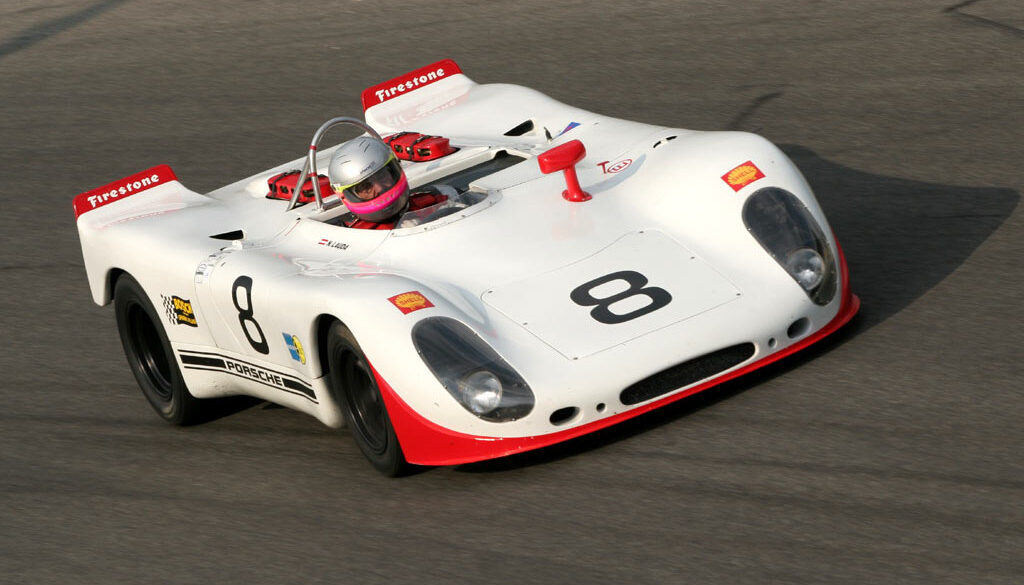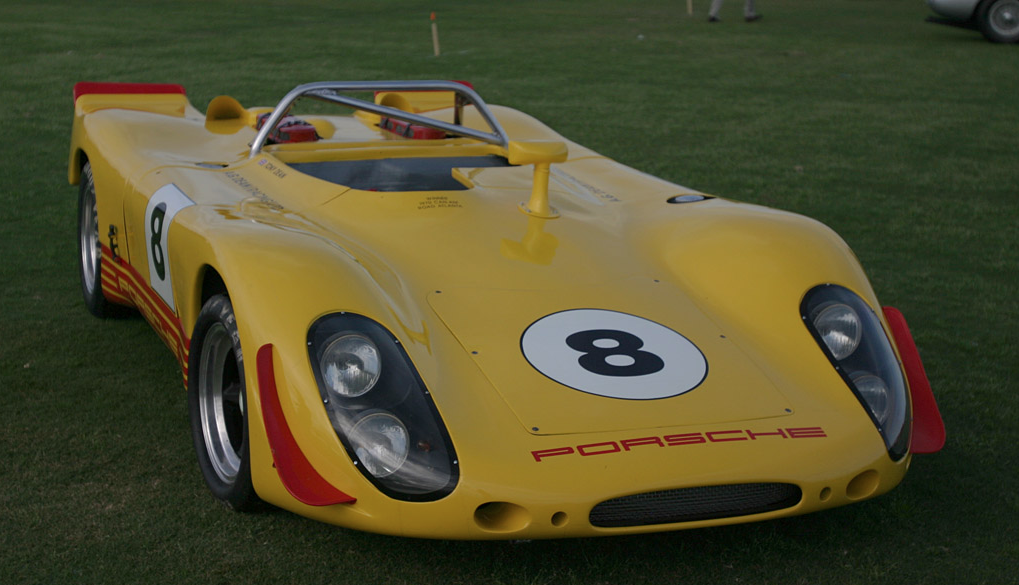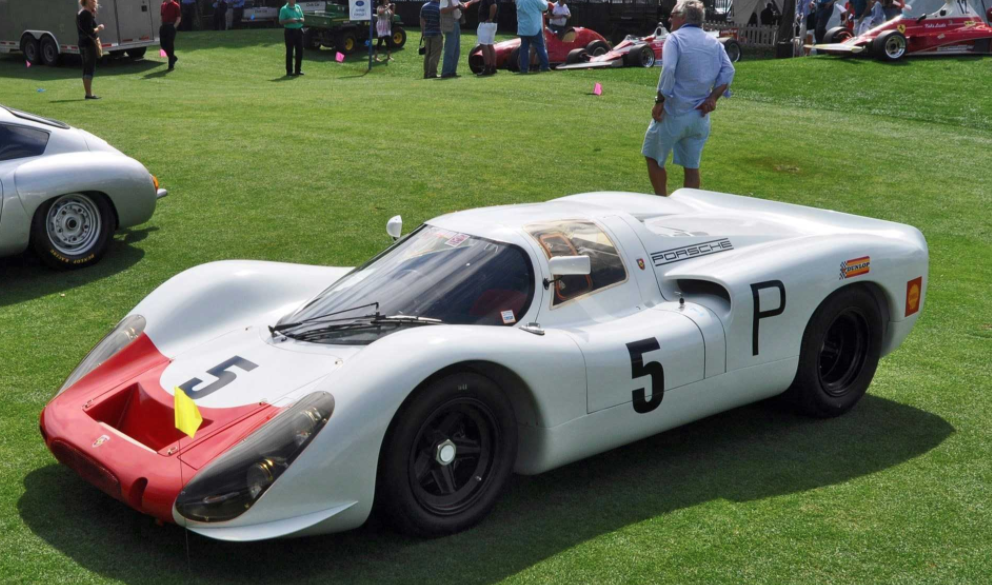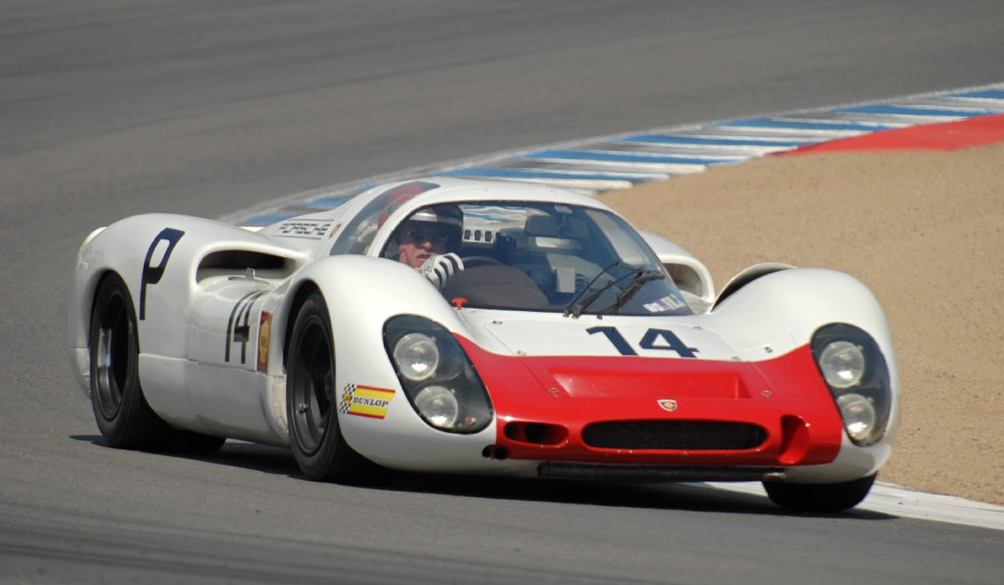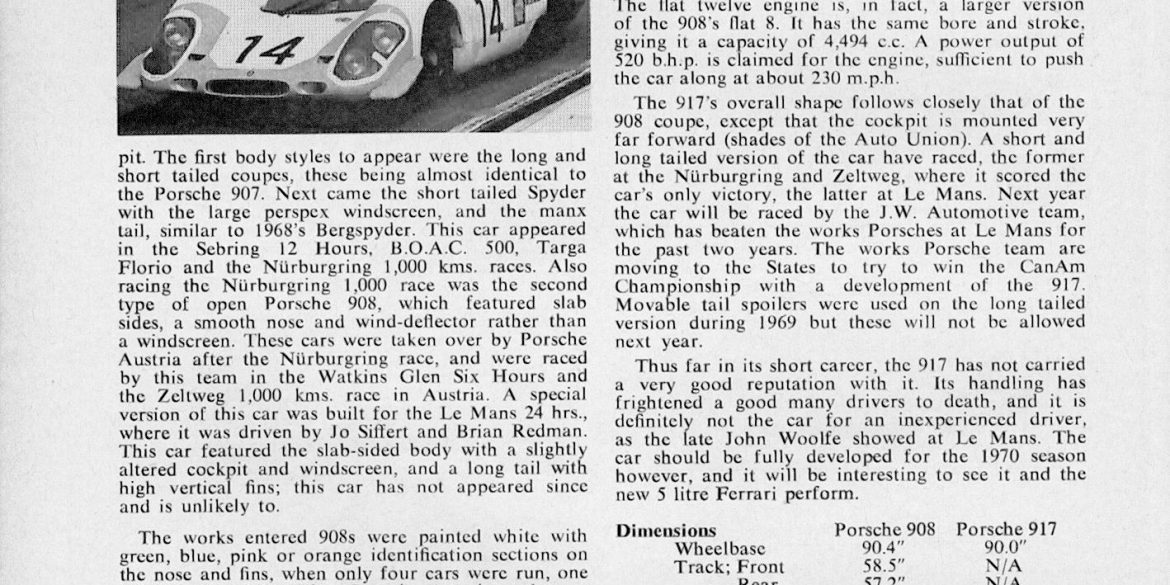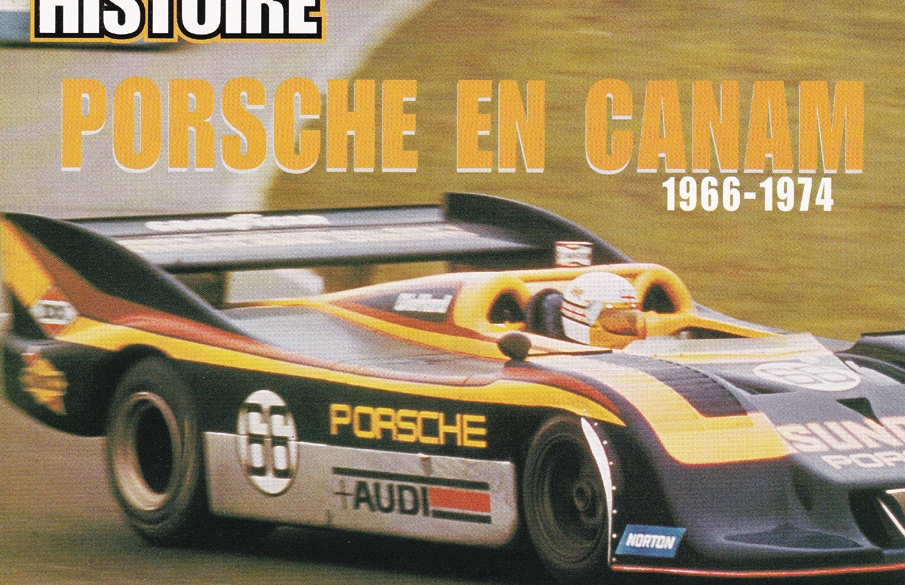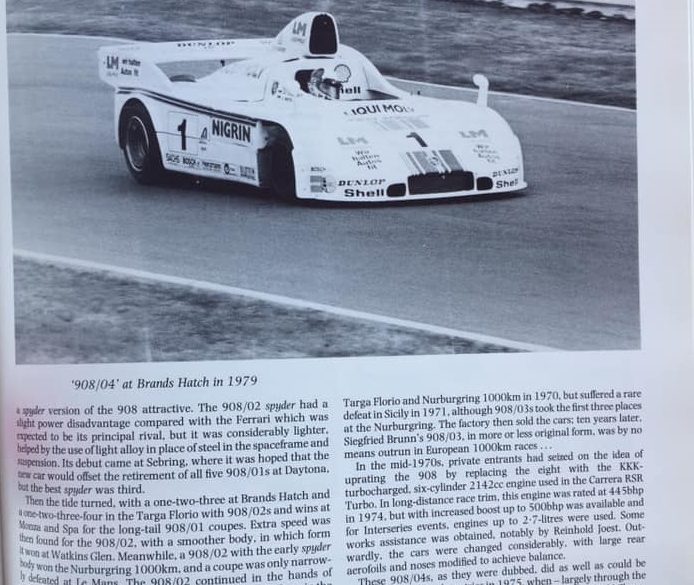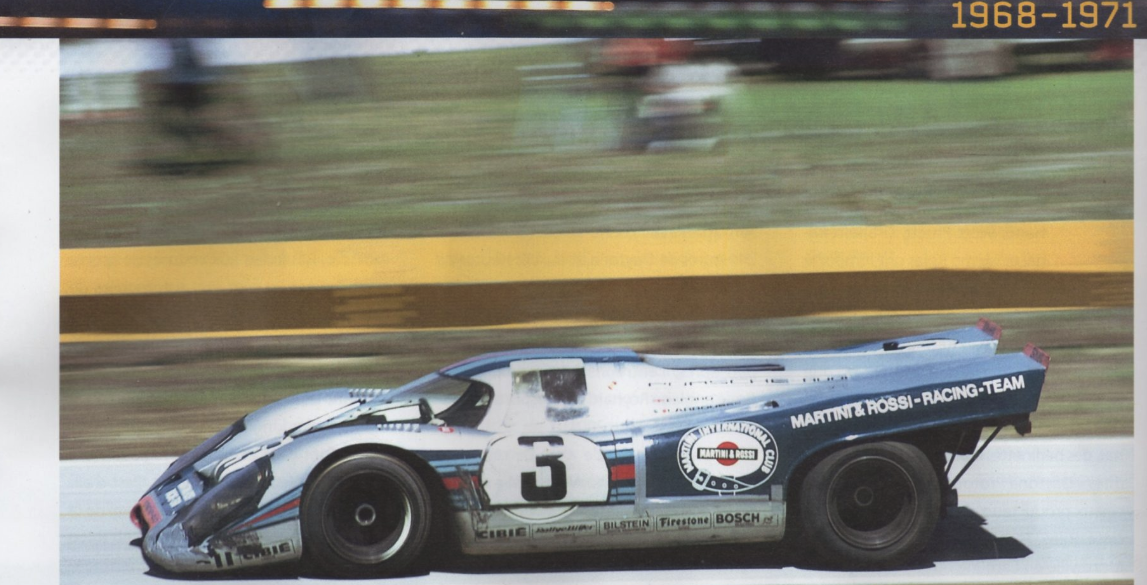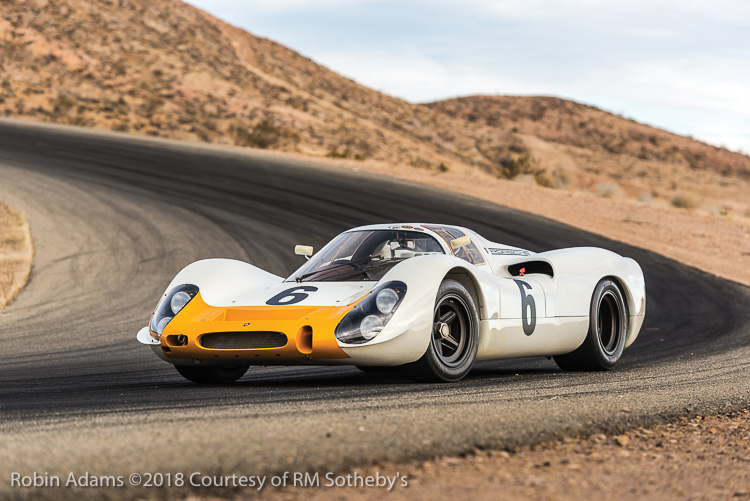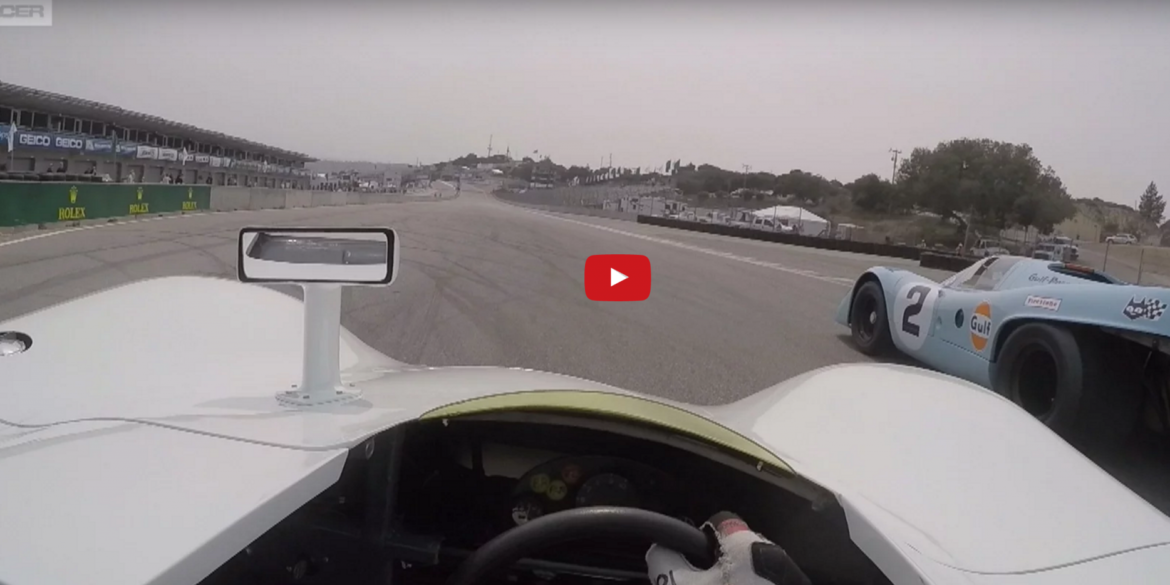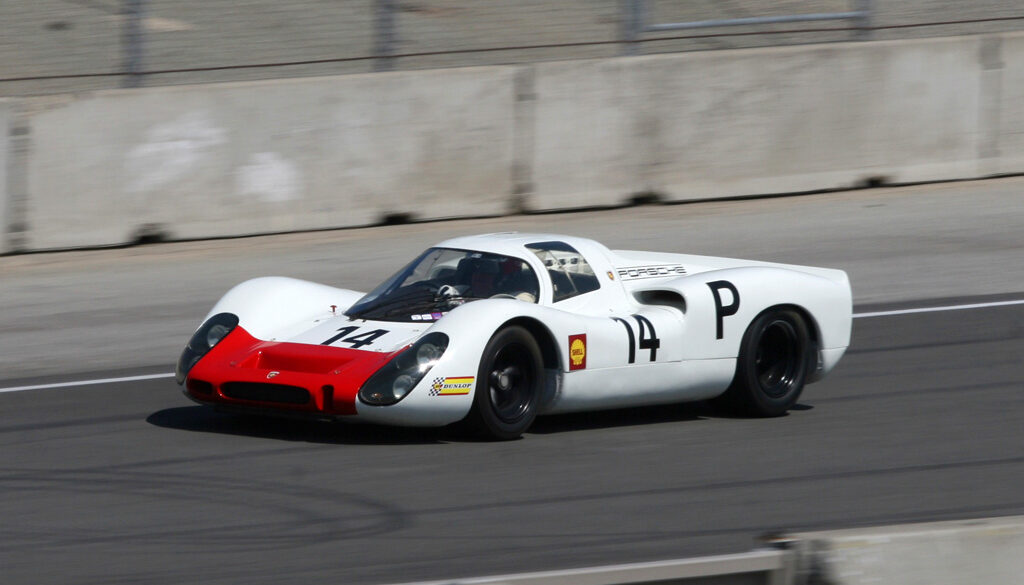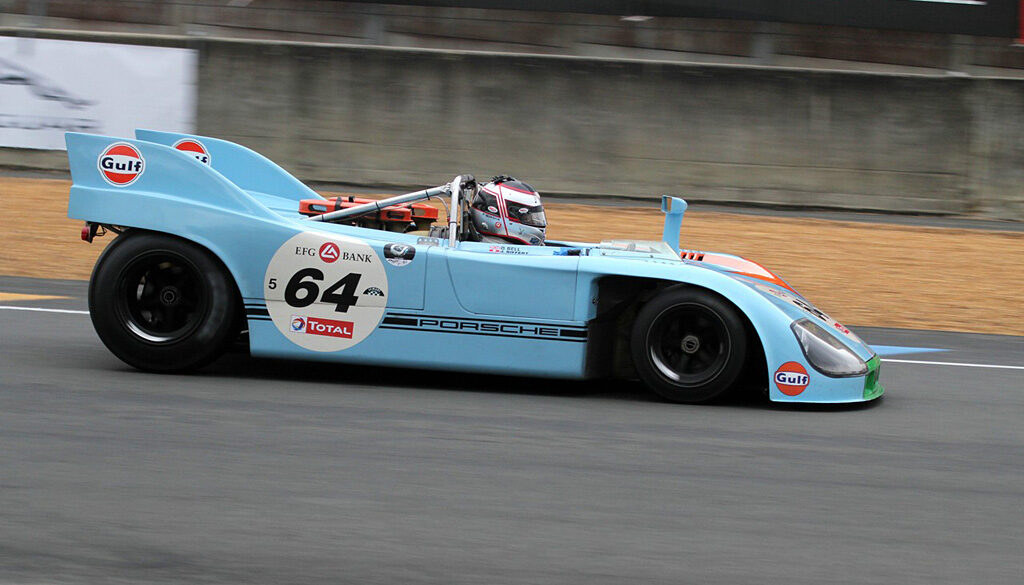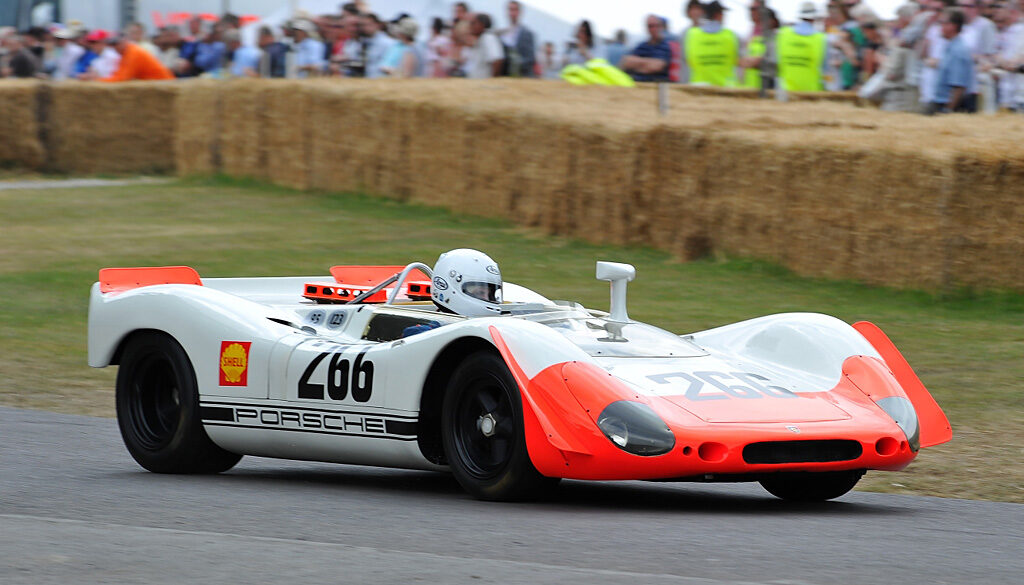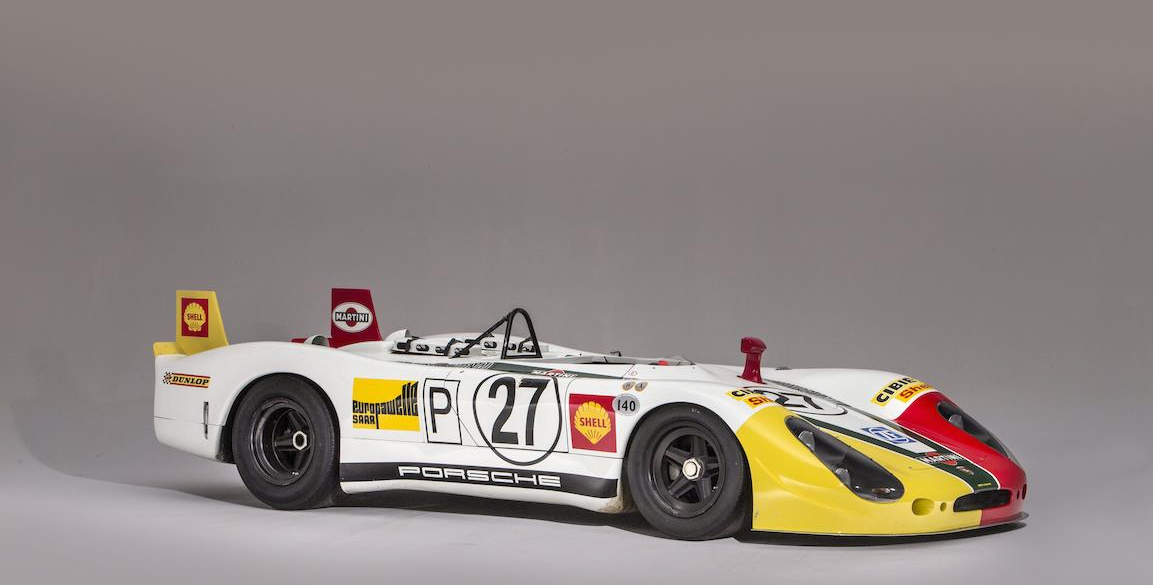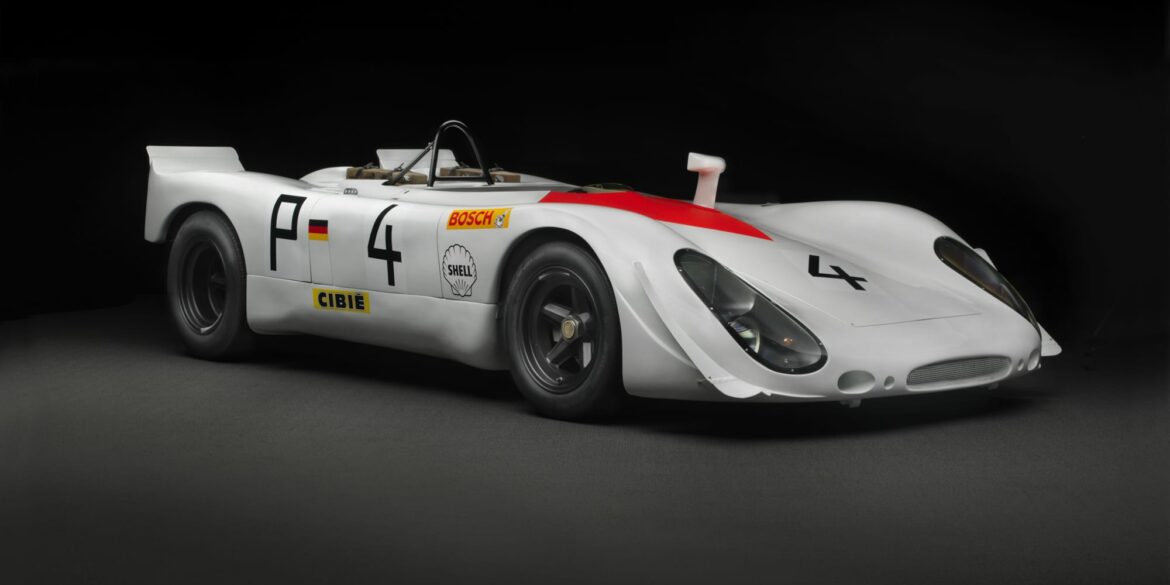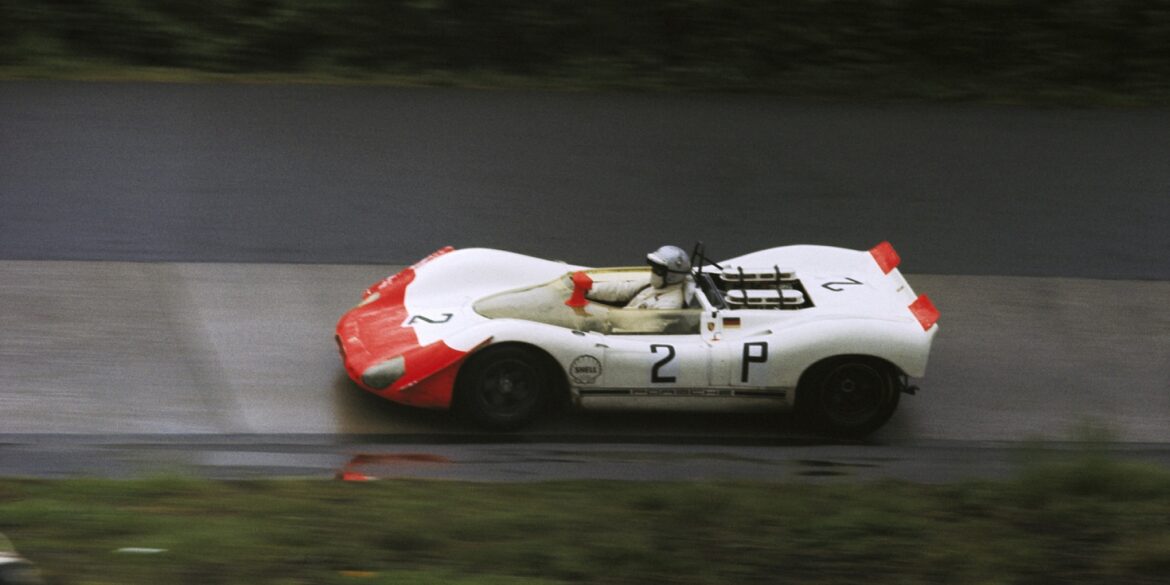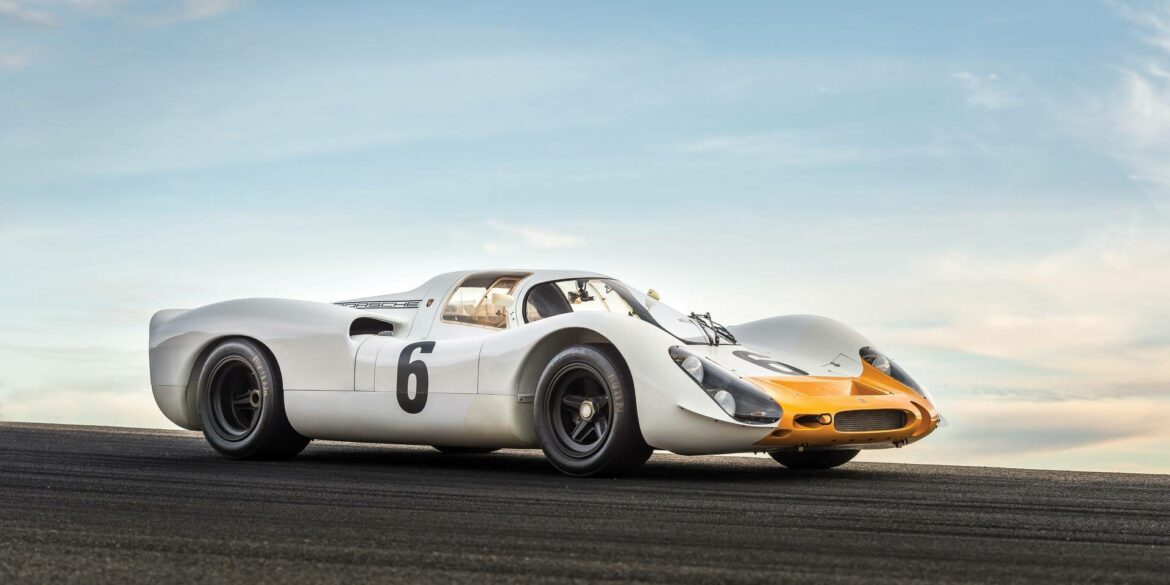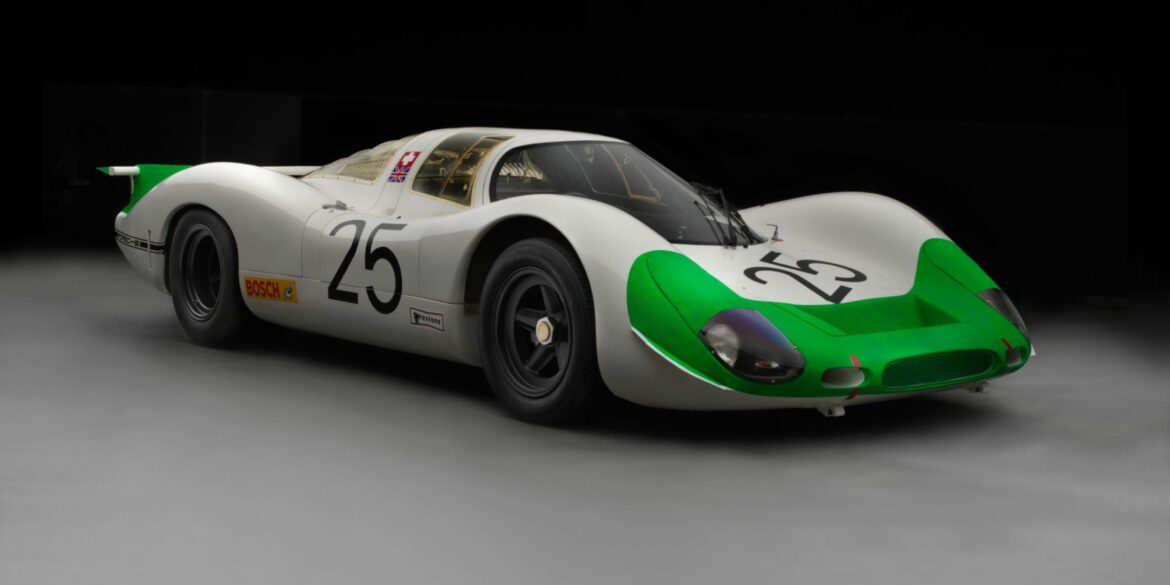Porsche designed the 908/03 with two specific races in mind: the Targa Florio and the Nürburgring 1000 KM. Both circuits, known for their tight and twisty layouts, demanded a car that was light, agile, and quick. To meet these challenges, Porsche took inspiration from the earlier 908/2 Spyder, which had...
Porsche 908
Porsche was a big underdog during the 1967 World Championship. Despite using engines no larger than 2.2 liters, Porsche lost the World Championship of Makes by one single point in 1967. Porsche decided to up engine size and even the odds. The 908’s mid-mounted engine was essentially a larger version of that used by the 2.2-liter 907. The FIA’s new three-liter prototype (Group 6) and five-liter sports car (Group 4) regulations adopted for 1968 presented the right opportunity. Porsche would build 31 examples of the 908 from 1968 to 1973 in both long-tail and short-tail coupe and Spyder configurations. See all Porsche 908 Research.
Words by: Glen Smale Images by: Glen Smale & Corporate Archives Porsche AG The Dependable 908 As previously noted, thanks to the revised Group 6 regulations for the 1968 season, the engine capacity limit was restricted to 3-litres. This allowed the Porsche factory racers to shift up a gear, becoming...
1968. The chassis was used at the April test races of Le Mans. In addition, two variants of the tail plumage were used: with a wing and without. No Subscription? You’re missing out Get immediate ad-free access to all our premium content. Get Started Already a Member? Sign in to...
The Porsche 908/3 is undeniably a unique car. Specifically crafted by Porsche for competition on only two circuits during the 1970 and 1971 World Sportscar Championship seasons—the Targa Florio and the Nürburgring Nordschleife—its lightweight design was revolutionary yet maintained exceptional weight distribution. Powered by a reliable and potent eight-cylinder flat...
Background The Porsche 908/02, an evolution of the initial 908 model, was introduced in 1969 as a response to the increasing competition in the FIA World Sportscar Championship. This variant optimized weight distribution and aerodynamics, yielding a lighter, open-cockpit configuration. The 908/02’s engineering was underscored by its advanced flat-8 engine,...
No Subscription? You’re missing out Get immediate ad-free access to all our premium content. Get Started Already a Member? Sign in to your account here....
The 908/3 prototype was built for the sole purpose of winning the Targa Florio and Nürburgring legs of the world Championship. The 908 specialized in lightweight design through the use of a 48 lbs titanium space frame and 26 lbs body. Known as the Porche miracle by Italians, the 908/3s won...
This Porsche 908/02 Flunder Spyder is one of the most extensively raced examples of one of Porsche’s most successful sports racing cars ever. In its inaugural season, chassis 908/02-018 was victorious with works pairing Jo Siffert and Brian Redman at the 1969 Watkins Glen 6 Hours – competing prolifically in...
The 903/3 prototype was built for the sole purpose of winning the Targa Florio and Nürburgring legs of the world Championship. The 908 specialized in lightweight design through the use of a 48 lbs titanium space frame and 26 lbs body. Known as the Porche miracle by Italians, the 908/3s won the...
No Subscription? You’re missing out Get immediate ad-free access to all our premium content. Get Started Already a Member? Sign in to your account here....
Watch the 1970 Porsche 908/3 Group 6 Prototype (chassis 001 and chassis 002) as they’re driven around on track....
Images by: Virtual Motorpix/Glen Smale and Corporate Archives Porsche AG The Porsche 908 is widely regarded as one of the Stuttgart manufacturer’s most reliable and important racers. The 908 came in many different guises, including Coupe, Spyder, long tail, short tail and turbo, and it excelled in all of these...
No Subscription? You’re missing out Get immediate ad-free access to all our premium content. Get Started Already a Member? Sign in to your account here....
No Subscription? You’re missing out Get immediate ad-free access to all our premium content. Get Started Already a Member? Sign in to your account here....
Porsche 908/03 Turbo Fly-by...
Porsche 908-3 at Rolex Monterey Motorsports Reunion A cool video showing a Porsche 908/3 at the hands of Gunnar Jeannette as he drives during the 2015 Rolex Motorsports Reunion in Monterey California....
Porsche 908/3 Gulf – Fly-bys, downshifts and revving A cool video showing a Porsche 908/3 doing fly-bys, downshifts and revving. Insane sounds....
Porsche 908 Visor Cam with Gunnar Jeanette Pro racer Gunnar Jeanette wields the 1969 Porsche 908/02 and puts all 350 hp from its 3.0-liter flat-8 to use in a wild sprint with a Porsche 917 during practice for the Rolex Monterey Motorsports Reunion. Thanks to Jeanette’s visor cam and a...
Porsche 908 LH racing at Rennsport V Onboard Lap Video Onboard lap of the historic Solitude race track in a 1970 Porsche 908-3 during the 2015 Solitude Revival....
Porsche 908/3 Awesome Onboard Lap Video Onboard lap of the historic Solitude race track in a 1970 Porsche 908-3 during the 2015 Solitude Revival....
Porsche 908/3 Flat-8 Engine On Track The Porsche 908/3 of this video is chassis 001 which was used by Porsche as test and development car. It’s now owned and driven by Peter Vögele. The car is moved by a 3.0 litre flat-8 engine which was able to produce more than...
Porsche 908 at Nurburgring 1971 The Gulf Porsche 908/3 Flunder was raced to victory in the Nurburgring 1000 km of 1971 by Derek Bell – Jo Siffert. ...
Porsche 908 LH Flat-8 Engine Sound – Warm Up, Accelerations & Downshifts This video is about a gorgeous Porsche 908 LH I saw at Imola Classic a few days ago. The car should be chassis number #004 which raced in the 1968 Monza 1000 km by Ludovico Scarfiotti and Gerhard...
No Subscription? You’re missing out Get immediate ad-free access to all our premium content. Get Started Already a Member? Sign in to your account here....
Porsche 908 LH “Flunder” Spyder Pictures The longer tail 908 Spyders were created only with the Flunder body – the body that’s upper surface is almost flat between the axles – and not with the “normal” curvy Spyder body. Very few LH Flunders were created, both with 908/02 and 908/01...
No Subscription? You’re missing out Get immediate ad-free access to all our premium content. Get Started Already a Member? Sign in to your account here....
No Subscription? You’re missing out Get immediate ad-free access to all our premium content. Get Started Already a Member? Sign in to your account here....
Porsche 908/02 “Flunder” Pictures The 908/02 K Spyder and 908 K Flunder Spyder were basically the same cars with slightly different bodyworks. If you look at the non-Flunder Spyder, you see that the body drops after the front wheel arch and rises again before the rear wheel arch. In the...
No Subscription? You’re missing out Get immediate ad-free access to all our premium content. Get Started Already a Member? Sign in to your account here....
Porsche 908K Coupé Specifications The 908 series caused a lot of headaches at Zuffenhausen. It was developed from the 907, so Porsche could have the largest engine the FIA allowed: a 3.0 flat-eight instead of a 2.2, producing 350 horsepower instead of just 270. The new race car started out...
Porsche 908/01 K Coupé Pictures It sure looks aerodynamic in these pictures, but the Porsche 908/01 K was anything but easy to drive at high speeds. In fact it was scary as hell and it weaved as it approached 200 mph. How can something so pretty be so scary? ...
No Subscription? You’re missing out Get immediate ad-free access to all our premium content. Get Started Already a Member? Sign in to your account here....
Introduced in 1968, the Porsche 908 was one of the longest running prototypes in the company’s history, as it was still doing duty twenty years later in 1988. The 908 took on many different forms, Long Tail (LH), Short Tail (KH), 908/02 Spyder, Flounder and 908/03 and Turbo, and it...
Porsche 908 Visor Cam with Gunnar Jeanette Pro racer Gunnar Jeanette wields the 1969 Porsche 908/02 and puts all 350 hp from its 3.0-liter flat-8 to use in a wild sprint with a Porsche 917 during practice for the Rolex Monterey Motorsports Reunion. Thanks to Jeanette’s visor cam and a...
Porsche 908/01 Coupé Pictures...
Porsche 908/03 Spyder Pictures In Porsche Museum collection...
Porsche 908/02 Spyder Pictures Introduced in 1969, the three-litre 908/2 is an evolution of the Porsche 908K Coupe. The Spyder body was perfectly suited for high downforce races like the Nürburgring 1000 km and the Targa Florio. It was also about 100 kg lighter than the Coupe. You can see from the pictures...
Porsche decided to end its 20-year history of factory sports car racing and sold the 908/03 cars to customers. In 1975, some 908s were fitted with turbocharged engines, similar to those used in the Porsche 934 GT car. Several customer-908s were upgraded with 936-style bodywork. The Porsche 908/80 Turbo of Joest and Jacky Ickx which finished 2nd in the 1980 24 Hours of Le Mans turned out later to have a real Porsche 936 chassis, though.
Although Porsche concentrated primarily on development of its twelve cylinder 917 from the middle of 1969, the eight cylinder 908 was also developed further. This 908 received a completely new tubular frame based on that of the 909 Bergspyder and its three liter engine was moved forward by mounting the gearbox ahead of the differential to achieve more equal weight distribution.
The longer tail 908 Spyders were created only with the Flunder body - the body that's upper surface is almost flat between the axles - and not with the "normal" curvy Spyder body. Very few LH Flunders were created, both with 908/02 and 908/01 chassis numbers. 908 LH Flunder Spyder was first used at the 1969 Le Mans 24h race by Jo Siffert and Brian Redman, but they had to retire because of the gearbox failure. The only excellent result was 3rda at the 1970 Le Mans.
The 908/02 K Spyder and 908 K Flunder Spyder were basically the same cars with slightly different bodyworks. If you look at the non-Flunder Spyder, you see that the body drops after the front wheel arch and rises again before the rear wheel arch. In the Flunder version, this concavity doesn't exist. The difference between the two versions was mainly visual, no difference in racing use. The first competition the Flunder was entered, was the Nürburgring 1000 km on June 1, 1969.
Introduced in 1969, the three-litre 908/2 is an evolution of the Porsche 908K Coupe. As the rule book for the season no longer required a minimum windscreen height nor the requirement to run a spare wheel, Porsche opted for a much lighter Spyder body; which looked like a chopped version of the short-tail Coupe used in 1968. The Spyder body was perfectly suited for high downforce races like the Nürburgring 1000 km and the Targa Florio. It was also about 100 kg lighter than the Coupe.
The Porsche 908/01 K Coupé was basically a 907 K with the new 3-litre flat-8. “K” in the designation stands for Kurz which is “short” in German, meaning the car had short-tail body compared to the 908 LH (“langheck”, long-tail). Although 907 and 908 were similar, there was a visual difference - the 907 had symmetrical front openings and the 908/01 K had asymmetrical. The 908/01 K debuted on May 19 at the Nürburgring 1000 km race and won it outright.
The FIA’s new three-liter prototype (Group 6) and five-liter sports car (Group 4) regulations adopted for 1968 presented the opportunity for Porsche to update its 907, which had won races but lost the championship. In came a 2997 cc flat-eight engined 908. Despite its aero appearance, it was no easy car to drive fast, weaving as speeds approached 200 mph. Despite winning the 1000km Nürburgring, the 908 was anything but convincing in 1968.


